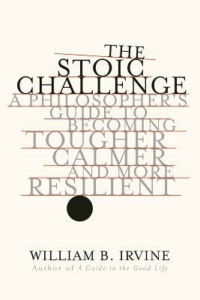THE STOIC CHALLENGE | William B Irvine | 2019
A Philosopher’s Guide to Becoming Tougher, Calmer, and More Resilient
This is a welcome sequel to The Good Life: The Ancient Art of Stoic Joy (2008) where Professor Irvine introduced us to the ancient concept of Stoicism. Apparently being stoic has got a bad rap over the years: coming to mean someone who accepts the parlous state of their situation without complaint, with indifference, even apathy. Nothing could be further from the truth of the meaning of Stoicism which expounds the theory of tranquillity as the basis for a happy life. And who doesn’t need a bit of tranquillity to help us cope with the rising stress of our fast paced, increasingly busy lives?
The Stoic Challenge is a gentle, thought-provoking guide to the principles of following the ways of the stoic philosophers of ancient Rome and Greece including Marcus Aurelius and Seneca. We’re introduced to the concepts of negative visualisation, handling setbacks, avoiding anger, anchoring and framing in this practical, updated guide to ancient wisdom. The chapter on building resilience when facing life’s setbacks is especially enlightening, even exciting, offering us a new viewpoint to everyday obstacles. And it’s quite sobering to think of how many days we might have left to live then counting them off as each day passes. Learning to value the life we have is at the heart of this book.
Bill Irvine shares some personal setbacks and how using stoic tools he was able to overcome anger as a way of facing his challenges and thus retain his equanimity and tranquillity. He even uses this philosophy to laugh at the tests he faces. Laughter really is the best medicine.
The author gives some famous examples of stoicism, the art of the bounce back, such as Stephen Hawking who gallantly faced the loss of the ability to move, along with young Bethany Hamilton who lost her arm to a shark attack and was back in the water a month later. They faced enormous setbacks but didn’t let that stop their driving force in life. Like a supple tree I’d much prefer to bend rather than break when faced with a setback.
As a non-religious person I’ve explored many philosophical tenets over the years. About twelve years ago I embraced the philosophy of Buddhism. Not the Buddhist religion as I eschew praying to idols, prostrating myself or saying ten thousand mantras on my day off. I think this is why the idea of Stoicism appealed to me as it did to Professor Irvine when he explored Zen Buddhism before settling on Stoicism as his life’s work and personal philosophy. Some reviewers have lambasted him for his ‘old white guy’ examples of his personal stoic challenges; however the principles of stoicism can apply to any age. Road rage and lost passports are tests of modern life not confined to the elderly.
Irvine’s previous book, A Guide to the Good Life is a great introduction to the topic but both books are equally interesting and beneficial for learning how to get the best out of life.

